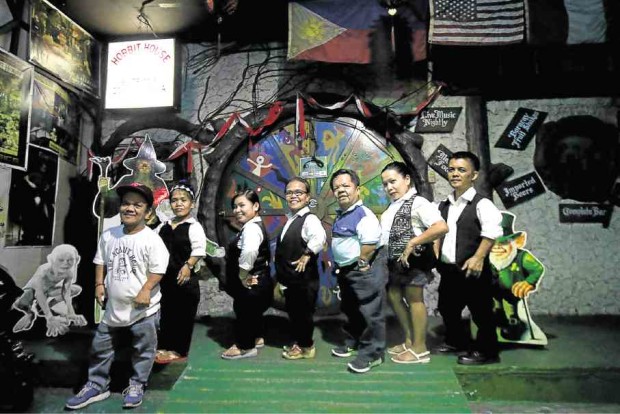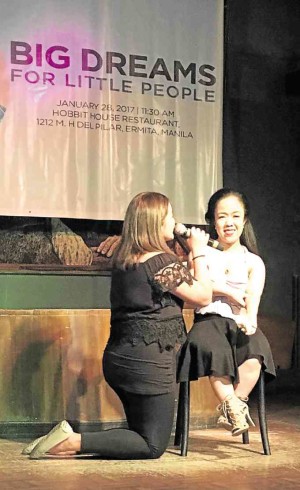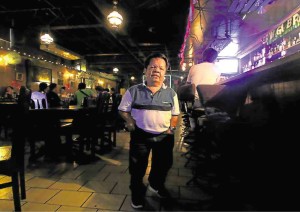Standing up for ‘little people’

STANDING PROUD AND TALL Petalino (third from right) and the service crew of Hobbit House —RICHARD A. REYES
Maria Gloria Tomen had done her makeup, a la Miss Universe, but had forgotten to bring a skirt that would have completed her smart casual getup for an event at the Hobbit House in Ermita district, Manila.
She was not rattled though. When a shawl wouldn’t do as an improvised skirt, Tomen shopped for a stylish but cheap pleated black piece.
Being resourceful easily describes this 26-year-old, who stands 3 feet 10 inches tall. It’s the one trait that helped bring to fruition her advocacy to make little people stand tall despite their medical condition known as dwarfism.
Tomen initiated Big Dreams for Little People (BDLP) to help others like her fight for a place among equals. The group held its first assembly on Jan. 28 at the J.R.R.Tolkien-inspired bar that the late American entrepreneur Jim Turner put up in 1973 to provide jobs for little people, whose options used to be limited to performing stunts for movies or being regarded as curiosities in carnivals.
Equal opportunities
“This is a small step toward our clamor for equal opportunities,” she told fellow short people Elpidio “Mang Pidoy” Petalino and Edward “Noy” Doble.
Petalino is a consultant while Doble serves as president of BDLP, the group to whom Turner bequeathed the assets and management of Hobbit House before he died in September last year.
Thirty of the group gathered at the bar and listened to solidarity messages from pop stars Jamie Rivera and Martin Nievera via the internet. Dr. Michael Ain of Johns Hopkins University School of Medicine and Becky Curran of Little People of America also greeted the members online.
Tomen—Toinkee to family and friends—picked up the cause of uplifting little people in 2012 through her aunt in the United States who opened her eyes to opportunities open to them despite their height.
Dwarfism summit
In a letter, Tomen’s aunt told her about a little person in her employ who drove a car, worked and raised a family much like average-size people.
Using her savings and money pooled from her parents and relatives, plus a 10-year visa from the US Embassy, Tomen attended the Little People of America conference in 2013 and 2014. In October 2016, she joined the first international dwarfism leadership summit in Berlin, Germany, which inspired her to organize BDLP.
She understood the issues of little people, as well as their condition known as dwarfism, beyond the popular belief that it happens in the course of a mother’s pregnancy when she develops cravings for small things.
In fact, dwarfism is caused by achondroplasia (the retarded growth of long bones), genetic incompatability, genetic mutation and about 200 more conditions. Making known such information, Tomen said, could help erase the stigma, prejudices and discrimination suffered by little people.
While little people are defined in the US to be below 147 centimeters (57.8 inches) in adult height, no such standard exists in the Philippines that could help them qualify for government assistance.
Social workers like Tess Briones considers them as people with disabilities to allow them access to physical aid, health support, education and employment.
It was what Tomen had in mind when BDLP made known it was seeking an audience with education and social welfare officials to check the government’s specific programs and projects for little people, how these were designed and how these will benefit them.
“We want to have a voice in society. Our being small is not an obstacle,” she said.
Her optimism was cultivated by people she loved. After taking a first look at Tomen, her father, Rex, said he drove back to Lubao town in Pampanga province “and cried and cried and cried” out of pity for her.
Bullied
“I won’t give her up because of (achondroplasia),” he recalled telling himself, despite finding no explanation for his child’s dwarfism. No one else had it on his and his wife’s side of the family.
It was Lulu, Tomen’s grandmother and a retired pharmacist, who taught her to be confident despite her size. When bullied or taunted, Tomen would snap back: “’E ano, Filipino naman ako! (So what? I’m Filipino after all).”
Tomen’s mother, Nina, meanwhile detested the word “midget,” and even wrote GMA 7’s “Kapuso Mo Jessica Soho” to protest the use of the term.
The Benedictine nuns at St. Scholastica’s Academy in San Fernando City were as supportive and gave Tomen a stool so she could access book shelves, toilets, sinks and cars.
She breezed through her mass communication course at Holy Angel University, and got herself a job at the information office of the Angeles City government. Others like her had dropped out of high school because of poverty and discrimination, Tomen said, adding that this partly explains why they were unable to get gainful employment.
Having a family life is as much an aspiration among little people who do not necessarily marry among themselves.
Acceptance
Petalino’s two children are as tall as their average-size mother, while Malou Asurio gave birth to a little person and another son who took after his father.
Petalino, 64, who stands 3 feet and 10 inches, said the love and acceptance of his wife and two children prodded him to work harder and be a good parent. His children now work in Dubai and Canada. “I raised them well and made sure they got educated,” said this former bit player in local movies who later took a jester’s role in an all-midget basketball team before heading the first batch of 12 waiters at the Hobbit House.
A strong family life also binds the Capote sisters—Girlie, Analie, Maricris and Juvy—who all took after their father, Javier, but harbor no anger nor resentment against him for their size. It is sheer survival they had to battle with, said Analie, who worked as a lady boxer after her day job, but quit two weeks later when her body could no longer take the hard blows.
Making peace with one’s self also helps a lot, said TV actor Miko Peñaloza, who said he coped with dwarfism by accepting himself and by being accepted by his family.
Little people should have the courage to make friends, counseled Cristina Torralba, to which Doble heartily agreed. After belting a rock song onstage during their January assembly, this BDLP president declared like an anthem: “The only difference is height.”
















